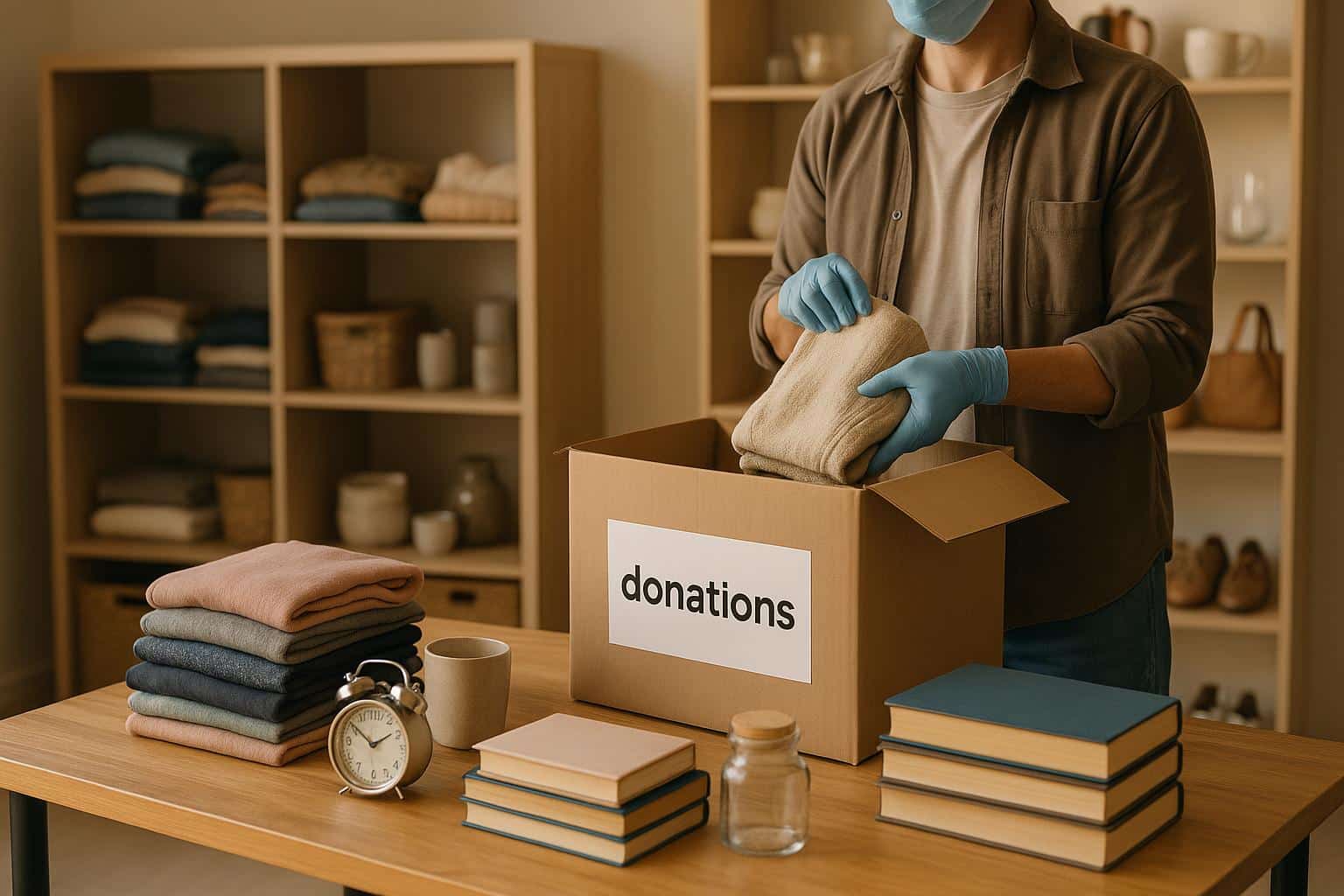Sorting donations efficiently is essential for thrift stores to save time, reduce waste, and maximize their impact. Here’s how you can do it in 5 simple steps:
- Check Donations Upon Arrival
- Immediately identify sellable items and reject unsellable ones (e.g., stained clothing, broken electronics).
- Set up a designated intake area to streamline this process.
- Set Clear Donation Guidelines
- Provide donors with clear rules on what is acceptable (e.g., clean, functional, and safe items).
- Use signage, websites, and social media to communicate these standards.
- Sort Donations by Category
- Organize items into main groups like clothing, electronics, furniture, and household goods.
- Further divide each category for better processing (e.g., men’s, women’s, and children’s clothing).
- Use an Inventory Management System
- Track donations, manage pricing, and monitor inventory in real-time with digital tools.
- Automate workflows to improve efficiency and reduce errors.
- Prepare Items for Display
- Clean, test, and repair items before putting them on the sales floor.
- Create attractive, organized displays to boost sales and customer satisfaction.
Step 1: Check Donations When They Arrive
The moment donations arrive, it’s crucial to determine whether items can be sold or if they’re unsuitable for resale. This first step can make or break the efficiency of your thrift store’s operations.
SMCo Thrift Store Consultants highlights the importance of this process:
In evaluating a thrift store processing operation, the expedient removal of non-sellable items is step number one after receiving a donation. There is nothing more detrimental than having a backroom operation that is not structured to identify and dispose of non-sellable items efficiently.
The financial burden of handling unsellable donations is significant. For example, Goodwill of Southern California spent over $2 million annually on trash removal for unusable items between 2016 and 2021, while Goodwill of West Texas allocates approximately $3 million each year to manage this issue.
At City Thrift, a strict initial screening process ensures that donations are processed efficiently and only quality items make it to the sales floor. This focus allows us to support City Union Mission’s programs, which address homelessness and poverty in Kansas City.
To streamline this process, set up a designated intake area separate from the shopping floor where staff can inspect incoming donations.
Questions to Ask During Initial Sorting
Training your team to ask the right questions is key to efficient sorting. Start with the basics: “Is this item safe to sell?” The U.S. Consumer Product Safety Commission offers a simple rule of thumb:
When in doubt, throw it out!
This is especially critical for children’s products, which must comply with the Consumer Product Safety Improvement Act (CPSIA) guidelines. Regularly check the Consumer Product Safety Commission’s list of recalled items to avoid accepting potentially hazardous products.
For clothing donations, ask: “Is this item clean and odor-free?” Items that smell, show heavy wear, or have broken zippers, missing buttons, or poor elasticity should be set aside. Clothing with stains, rips, or other damage also doesn’t belong on the sales floor.
Electronics and appliances need extra scrutiny. Ask: “Does this item turn on and function safely?” Always test these items to ensure they work properly and meet safety standards before making them available to customers.
For furniture and household items, check for sturdiness and usability by asking: “Is this item functional without repairs?” Items requiring fixes can drain staff time and occupy valuable storage space.
Kyle Payton, Product Manager at ThriftCart, offers this advice:
We’ve seen stores save hundreds of dollars just by reviewing photos before pickup or dropoff. It gives staff the ability to say yes or no without wasting time or space.
Remove Items That Cannot Be Sold
Rejecting unsellable items right away saves time and prevents clutter in your backroom. As SMCo Thrift Store Consultants advises:
The best time to eliminate non-sellable items is always as the donation is received.
Here’s a breakdown of what to decline:
- Clothing rejections: Items with permanent stains, holes, rips, or excessive wear. Avoid undergarments and socks unless they’re new and in original packaging. Clothing with strong odors, such as smoke or mildew, should also be refused.
- Safety hazards: Immediately remove recalled products, broken nursery furniture, car seats, cribs, or strollers with missing parts. Never accept chemicals, explosives, or items that could pose risks to staff or customers.
- Hygiene concerns: Mattresses, items with bodily fluids, excessive pet hair, or anything unsanitary should be declined due to health risks like bedbugs.
- Broken or non-functional items: If an item needs repairs before it can be used, it’s better suited for recycling than resale.
To handle rejected items responsibly, set up marked bins for recycling, textile recycling, and trash. This system ensures proper disposal while minimizing environmental impact.
Finally, train your team to politely but firmly decline unsuitable donations. Explaining that quality standards are in place to maximize the impact of donations helps donors understand the value of their contributions.
Step 2: Set Clear Donation Guidelines
Clear and specific donation guidelines help reduce unusable items and ensure your inventory remains high-quality. When donors know exactly what’s needed, they’re more likely to bring items that can be sold, saving your team valuable time on sorting and disposal.
Kyle Payton, an expert in donation management, explains:
Clear rules on acceptable donations control both volume and quality. By putting some responsibility on your donors, you ensure your staff receives suitable, high-quality items, streamlining the sorting process.
Research backs this up: a study involving 763 donors found that clear guidelines improved donation quality by 15% and reduced unusable items by 50%.
At City Thrift, implementing clear donation rules has led to higher-quality contributions, directly increasing proceeds for City Union Mission’s programs addressing homelessness and poverty.
What Makes a Good Donation Guideline?
Effective guidelines should emphasize that all items must be clean, safe, and resaleable. Items with stains, damage, or safety concerns should be explicitly marked as unacceptable. This transparency not only helps donors feel confident that their contributions will make a meaningful impact but also prevents items from ending up in landfills.
Year-Round vs. Seasonal Guidelines
To manage inventory effectively, divide your guidelines into two categories: permanent and seasonal.
- Permanent guidelines cover items that are always in demand, such as clothing in good condition, working electronics, sturdy furniture, and household goods. Set clear minimum standards, like clothing without stains or tears, electronics that function properly, and furniture that doesn’t require repairs.
- Seasonal guidelines focus on items with limited selling windows. For example, Christmas decorations should only be accepted a few months before the holiday season, while summer clothing is best donated in late spring, and winter coats are most useful when received in early fall.
Creating a seasonal calendar can help streamline this process. Share this calendar with your regular donors to set expectations and keep your inventory aligned with customer demand.
Sharing Your Guidelines with Donors
To maximize the effectiveness of your guidelines, make them easy to find and understand. City Thrift uses multiple channels to communicate donation standards clearly.
- On-site signage: Place clear signs at all drop-off points listing acceptable and unacceptable items.
- Website: Dedicate a page to donation guidelines, complete with detailed descriptions and photos showing examples of acceptable and unacceptable items. Offer a downloadable checklist to help donors confirm their items meet your standards.
- Social media: Pin your donation guidelines to the top of your Facebook and Instagram profiles. Regular posts featuring reminders and photos of ideal donations can reinforce your messaging.
Ryan Christensen, Director of Customer Success at ThriftCart, highlights the benefits of proactive communication:
Donation scheduling gives you a buffer. It lets stores plan for volume, reduce sorting bottlenecks, and filter what they actually accept.
Kyle Payton adds:
We’ve seen stores save hundreds of dollars just by reviewing photos before pickup or dropoff. It gives staff the ability to say yes or no without wasting time or space.
Training Staff and Volunteers
Equip your team with the tools and language they need to politely decline unsuitable donations. Clear communication is key – explain why certain items can’t be accepted and emphasize how maintaining high standards ensures every donation makes the greatest impact.
Encourage donors to use reusable bags when dropping off items. This small step can lead to better-quality donations and reduce waste.
Step 3: Sort Donations into Categories
Once you’ve set clear donation guidelines, the next step is to organize donations into specific categories. This approach makes it easier to evaluate, price, and display items while ensuring an efficient workflow.
Main Categories for Sorting
To keep everything running smoothly, divide donations into the following six categories. This ensures each item is processed appropriately:
- Clothing and Accessories
This includes tops, pants, outerwear, shoes, belts, jewelry, and handbags. Since clothing often makes up the largest portion of donations, having a clear system here can save a lot of time. - Household Items
This category covers a wide range of items like kitchenware, small appliances, home décor, linens, and cleaning supplies. Think coffee makers, picture frames, and everything in between. - Furniture
Chairs, tables, dressers, lamps, and storage units fall into this group. These items need prompt identification and careful handling due to their size and weight. - Electronics
Working devices such as laptops, phones, gaming consoles, televisions, and audio equipment belong here. A quick functionality test is essential before pricing and putting them on display. - Books, Media, and Toys
This group includes novels, textbooks, CDs, DVDs, toys, games, and puzzles. These items often share similar storage and display needs. - Collectibles and Vintage Items
Antiques, artwork, rare books, vintage clothing, and unique decorative pieces go here. These often require additional research to determine their value.
For instance, Goodwill Central Coast introduced a sorting system in March 2025 that focused on clothing, household goods, books and media, and electronics to make their donation process more efficient.
Sort Items Within Each Category
Once you’ve set up the main categories, further sorting within each group makes evaluation and processing even more efficient. Here’s how you can break things down:
- Clothing: Separate items by gender (men, women, children) and then by type, such as shirts, pants, dresses, outerwear, and shoes. If possible, group items by season as well.
- Household Items: Organize by function – for example, keep kitchen items like dishes, cookware, and small appliances together, and separate cleaning supplies, décor, and linens.
- Electronics: Immediately separate working devices from broken ones. Test functionality in a designated area and keep all cables, chargers, and accessories together.
Having designated areas, carts, or pallets for each group in your backroom can help your team move and sort items quickly. This setup ensures consistent quality and speeds up the evaluation process.
“Establishing an effective sorting system can be the difference between organized chaos and a thrift store that runs like a dream.”
Check Item Quality and Condition
After the initial sorting, take time to assess the quality of each item. Each category benefits from its own set of quality checks.
- Grading System: Use a simple grading system like “excellent”, “good”, “fair”, and “as-is” to quickly determine whether an item is ready for resale.
- Clothing: Look for tears, missing buttons, faulty zippers, stains, or excessive wear. Minor issues can be repaired, but severely damaged items should be set aside.
- Electronics: Test all devices to ensure they work. Non-functional items should be recycled.
- Books, DVDs, and CDs: Check for major damage, such as broken covers, missing pages, or scratched discs.
- Safety and Cleanliness: Remove any recalled products, expired goods, or items that pose safety risks. Dirty, stained, or smelly items should either be cleaned immediately or discarded.
City Thrift uses this thorough quality-check process to ensure only the best items make it to the sales floor. This not only helps maintain their reputation but also supports their mission to aid City Union Mission’s programs. By focusing on quality, they ensure every item on display meets high standards.
Step 4: Use an Inventory Management System
Implementing a digital inventory management system can completely change how thrift stores handle donations, from the moment they’re received to when they’re sold. It’s a game-changer for making operations smoother and more organized.
How Inventory Systems Help Thrift Stores
Digital inventory systems simplify the entire process by tracking donations, managing pricing, categorizing items, and generating sales reports – all in one place.
One major benefit is real-time tracking. Instead of juggling handwritten logs or spreadsheets, staff can see exactly what’s in stock at any moment. This prevents overselling and helps identify items that aren’t selling well, so you can adjust pricing accordingly.
These systems also make it easier to handle large donation volumes. They track where each item came from, when it was donated, and its status as it moves through processing. This is especially useful during busy seasons when donations come in fast and furious.
Another key feature is pricing optimization. With access to real-time sales data, you can set prices that reflect what’s selling and what’s not. This data-driven approach takes the guesswork out of pricing.
By consolidating all this information into one system, inventory software provides valuable insights that support smarter decision-making. It reduces manual work, speeds up donation intake, and sets the stage for advanced techniques like those used by City Thrift.
City Thrift‘s Inventory Management Methods
City Thrift has taken these benefits to the next level. Across its Kansas City locations, the organization uses customized systems to streamline donation processing, all while supporting City Union Mission’s programs for homelessness and poverty relief.
They’ve implemented barcode scanning and tagging, which allows staff to quickly log details like condition, price, and category. This eliminates the need for handwritten tags and reduces errors in pricing, saving time and effort.
An automated workflow ensures every item is tracked from donation to sale. The system keeps tabs on quality checks, pricing, and sorting, helping staff spot and resolve any bottlenecks in the process.
City Thrift’s system also enhances donor management. When someone donates, the system can generate tax receipts and track donation patterns. This data helps the organization anticipate peak donation times and plan staffing accordingly.
Detailed reporting shows which items sell best at each location, enabling smarter inventory distribution across stores.
“We built this application to help thrift retailers gain better insights and processes with inventory management, ultimately helping to fuel better customer shopping experiences. Our goal is to make the management of thrift stores as efficient and effective as possible, enabling our clients to focus more on what matters most – their customers.” – Matt Gallant, Director of Operations, Retail Control Systems
City Thrift also ensures their system works offline, so operations continue seamlessly even during internet outages. This ensures every donation contributes effectively to supporting City Union Mission’s initiatives.
Step 5: Prepare Donations for Display and Sales
Once you’ve sorted and tracked your donations through inventory management, the next step is turning those items into merchandise that customers will want to buy. How you prepare and present these items plays a big role in boosting sales and keeping customers happy.
Get Items Ready for Display
Before anything goes on the sales floor, cleaning is a must. Wash all clothing donations to ensure they’re fresh, hygienic, and odor-free. For items that can’t be washed traditionally, like certain fabrics or materials, spot-cleaning or airing them out works well.
For luxury or high-end items, professional cleaning is often the way to go. Designer clothes, upscale accessories, and valuable collectibles need special care to maintain their appeal and justify higher price tags.
While cleaning, check for small imperfections like loose buttons, minor tears, or missing parts. Fixing these simple issues makes items more appealing to buyers.
When it comes to electronics and appliances, always test them before putting them on display. This ensures they work properly, builds trust with customers, and reduces the chances of returns.
Once cleaned, repaired, and tested, your items are ready to shine on the sales floor.
Set Up Attractive Displays
The way you present your merchandise can make all the difference. An eye-catching display not only encourages sales but also helps fulfill your mission by turning donations into community support.
Start by grouping similar items. Create clear sections for clothing, books, appliances, and household goods. For clothing, organize by gender, size, style, and even color to make shopping easier and more enjoyable.
For added visual appeal, arrange items by color families. This makes displays pop and helps customers find what they’re looking for faster.
“When in doubt, color it out.” – Michelle Sherrier, Owner of MC Design Collaboration
Alphabetical organization works wonders for books, movies, and music. Shoppers love being able to locate specific titles quickly, and it encourages them to stick around and browse more.
If you have vintage or premium items, create special sections to showcase them. Use high-quality display fixtures, good lighting, and place these sections in high-traffic areas like entrances or window displays to grab attention.
Staging items together is another effective way to inspire customers. For example, pair a cozy chair with a side table and a lamp to show how they can work as a set. This approach helps customers visualize how items fit into their own spaces.
Seasonal displays are a game-changer. Rotate items to match the time of year, holidays, or local events. Highlight winter coats and holiday decorations in December, or feature patio furniture and lightweight clothing during the summer months.
Strategic placement is key. Showcase your best items in window displays, near the entrance, or at checkout counters. The checkout area is especially great for small accessories and impulse buys.
Lighting and ambiance matter, too. Good lighting draws attention to item details, while soft background music creates a relaxed shopping vibe. Adding plants or natural elements can make the space feel even more inviting.
Finally, clear signage is essential. Use it to guide customers to different sections, highlight special deals, or share your organization’s mission. Bold, well-designed signs can also emphasize the positive community and environmental impact of shopping at your store.
Keep Displays Fresh
Maintaining your displays throughout the day is just as important as setting them up. Tidy up regularly, restock sold items, and keep sections organized. Fresh, well-maintained displays give customers a reason to return and see what’s new.
Getting the Most Value from Donations
City Thrift has perfected the art of turning donations into meaningful contributions by emphasizing efficient screening, clear guidelines, organized sorting, accurate inventory tracking, and strategic display. These steps transform what could be chaotic into a well-oiled system, ensuring every donation counts toward supporting City Union Mission’s efforts to combat homelessness and poverty.
Streamlining the sorting process not only saves time but also increases sales and enhances customer satisfaction. This method minimizes waste disposal expenses while maximizing funds for City Union Mission’s essential services, avoiding unnecessary costs that can hinder many organizations.
With proper planning, stores can effectively manage donation volumes, eliminate sorting bottlenecks, and maintain high-quality standards. This approach ensures that only the best items make it to the sales floor, maximizing both sales potential and community impact.
Additionally, thoughtful sorting contributes to environmental responsibility by keeping textiles and other materials out of landfills. Items that don’t meet sales criteria can still serve the community through recycling, repurposing, or direct donations to those in need.
Maintaining quality control is crucial. By ensuring that only clean, well-organized, and appealing merchandise reaches the sales floor, City Thrift creates a shopping experience that keeps customers coming back – and recommending the store to others.
This efficient sorting process doesn’t just improve operations; it creates a ripple effect. More shoppers mean higher sales, which lead to increased funding for critical programs. Satisfied donors are more likely to continue providing quality items, fueling a sustainable cycle that keeps City Thrift’s mission alive and thriving. Ultimately, it’s about serving Kansas City’s most vulnerable residents with dignity and respect.
Every thoughtfully sorted item becomes part of a bigger picture – one where second-hand goods pave the way for new opportunities. Each piece not only boosts sales but also strengthens City Thrift’s dedication to helping individuals and families rebuild their lives.
FAQs
What’s the best way for thrift stores to share donation guidelines and encourage high-quality contributions?
Thrift stores can make donation guidelines more effective by keeping them clear, straightforward, and easy to find. Place bold, attention-grabbing signs at donation drop-off spots, ensure your website has up-to-date instructions, and regularly post reminders on social media. You can also highlight seasonal needs or specific high-demand items to help donors make informed choices.
Another crucial step is educating donors about the value of quality donations. A simple “Yes/No” list of acceptable items can clarify expectations and minimize unsellable contributions. Additionally, sharing how donations directly benefit the community, whether by funding local programs or assisting individuals in need, can encourage thoughtful, intentional giving. This not only improves the quality of donations but also strengthens the store’s bond with the community.
Why Use an Inventory Management System for Thrift Store Donations?
What are the advantages of using an inventory management system for organizing thrift store donations?
An inventory management system can be a game-changer when it comes to handling thrift store donations. It simplifies the sorting and categorization process, allowing staff to quickly and accurately assess, price, and organize incoming items. This not only saves time but also minimizes mistakes that can happen with manual methods. Plus, with real-time tracking, it helps keep operations running smoothly, even during those unpredictable donation rushes.
Another big perk? It ensures fair and consistent pricing by factoring in the condition of items and their demand. This consistency not only boosts customer trust but also helps maximize revenue. In short, an inventory system can make your store more efficient while creating a better shopping experience for your customers.
Why is it important to sort thrift store donations into specific categories?
Sorting thrift store donations into clear categories – like clothing, electronics, and household items – is a key part of keeping things running smoothly. It allows staff to process and organize items more efficiently, cutting down the time it takes to prepare them for display. This steady flow of inventory to the sales floor not only boosts sales but also enhances the store’s ability to make a positive impact in the community.
Organizing donations also helps spot damaged or unsellable items faster, which keeps the quality of other goods intact and ensures the workspace stays clean and safe. With a solid system in place, staff can spend more time focusing on providing great service and supporting important community programs, such as those backed by City Thrift.







Leave A Comment